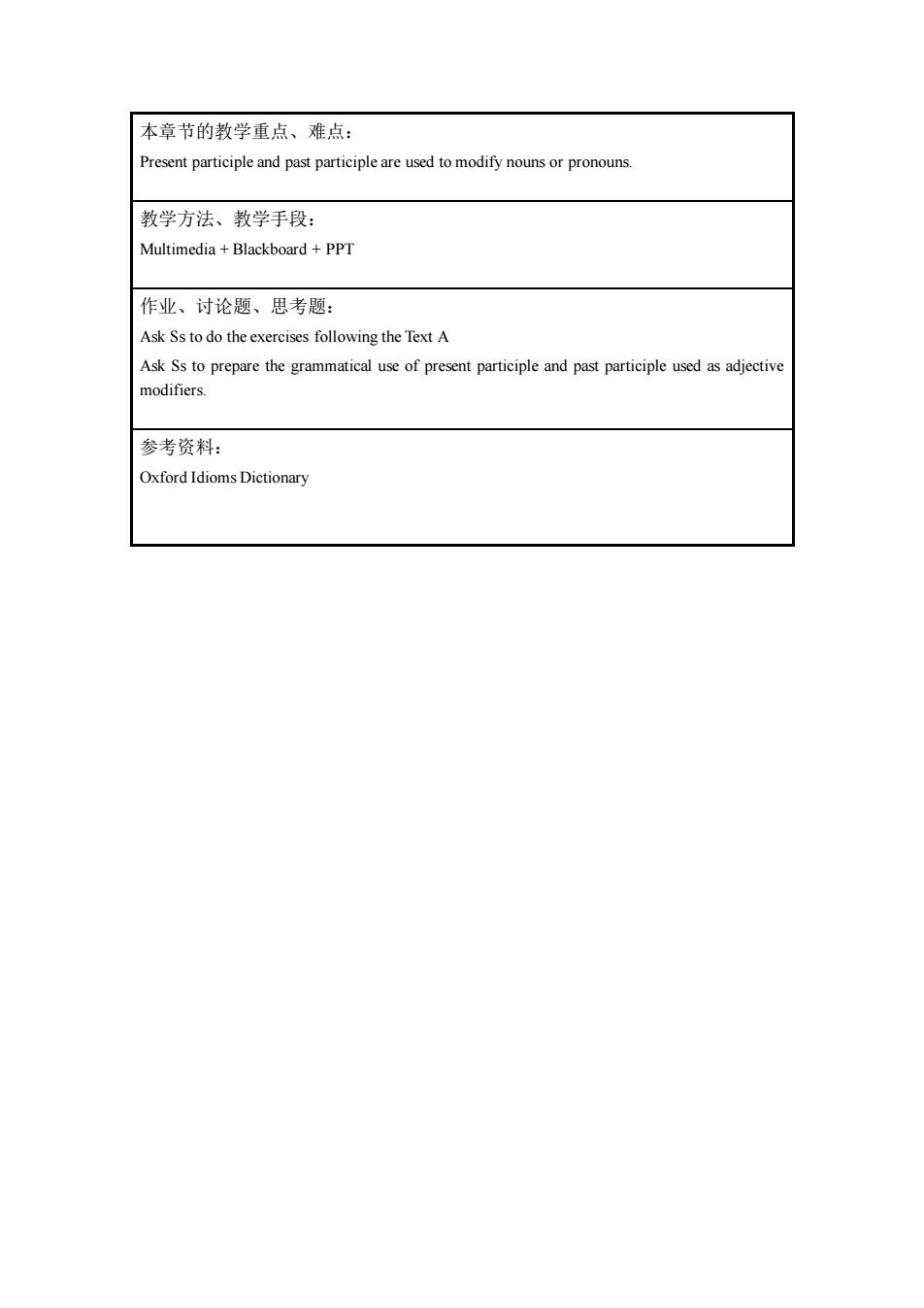
本章节的教学重点、难点: Present participle and past participleare used to modify nounsor pronouns 教学方法、教学手段: Multimedia+Blackboard+PPT 作业、讨论题、思考题: Ask Ss to do the exercises following the Text A Ask Ss to prepare the grammatical use of present participle and past participle used as adjective modifiers. 参考资料: Oxford Idioms Dictionary
本章节的教学重点、难点: Present participle and past participle are used to modify nouns or pronouns. 教学方法、教学手段: Multimedia + Blackboard + PPT 作业、讨论题、思考题: Ask Ss to do the exercises following the Text A Ask Ss to prepare the grammatical use of present participle and past participle used as adjective modifiers. 参考资料: Oxford Idioms Dictionary
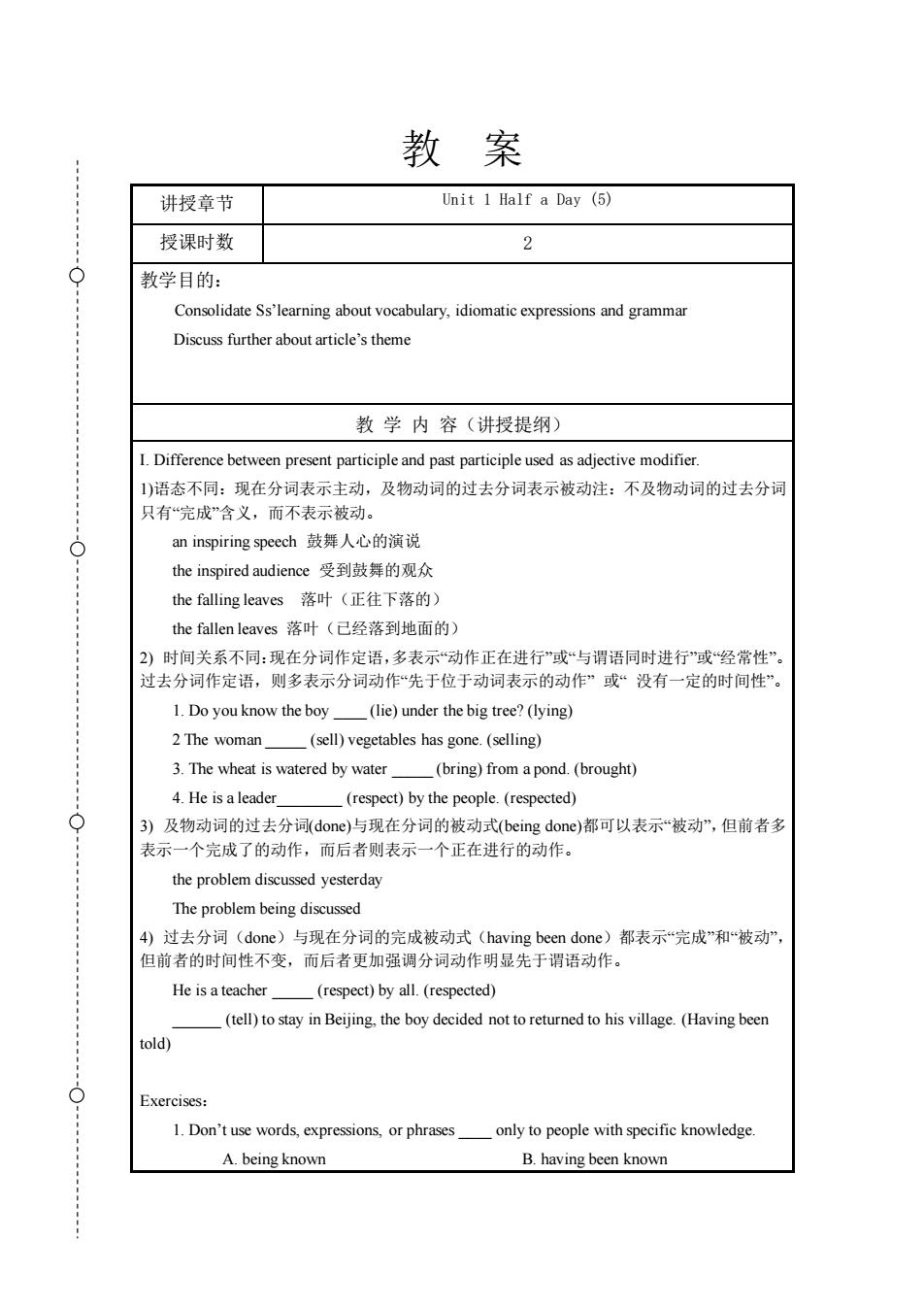
教案 讲授章节 Unit 1 Half a Day (5) 授课时数 教学目的: Consolidate Ss'learning about vocabulary,idiomatic expressions and grammar Discuss further about article's theme 教学内容(讲授提纲) I.Difference between present participle and past participleused as adjective modifier. 1)语态不同:现在分词表示主动,及物动词的过去分词表示被动注:不及物动词的过去分词 只有“完成”含义,而不表示被动。 an inspiring speech鼓舞人心的演说 the inspiredaudiee受到鼓舞的观众 the falling leaves落叶(正往下落的) the fallen leaves落叶(已经落到地面的 2)时间关系不同:现在分词作定语,多表示“动作正在进行或“与谓语同时进行"“或“经常性”。 过去分词作定语,则多表示分词动作先于位于动词表示的动作”或“没有一定的时间性”。 1.Do you know the boy(lie)under the big tree?(lying) 2 The woman. (sell)vegetables has gone.(selling) 3.The wheat is watered by water(bring)from a pond.(brought) 4.He is a leader (respect)by the people.(respected) 3)及物动词的过去分词done)与现在分词的被动式(being done)都可以表示“被动”,但前者多 表示一个完成了的动作,而后者则表示 一个正在进行的动作 the problem discussed vesterdav The problem being discussed 4)过去分词(done)与现在分词的完成被动式(having been done)都表示“完成和“被动 但前者的时何性不变,而后者更加强调分词动作明显先于谓语动作 He is a teacher(respect)by all.(respected) (tell)to stay in Beijing.the boy decided not to returned to his village.(Having been told) Exercises: 1.Don't use words,expressions,or phrases only to people with specific knowledge A.being known B.having been known
教 案 讲授章节 Unit 1 Half a Day (5) 授课时数 2 教学目的: Consolidate Ss’learning about vocabulary, idiomatic expressions and grammar Discuss further about article’s theme 教 学 内 容(讲授提纲) I. Difference between present participle and past participle used as adjective modifier. 1)语态不同:现在分词表示主动,及物动词的过去分词表示被动注:不及物动词的过去分词 只有“完成”含义,而不表示被动。 an inspiring speech 鼓舞人心的演说 the inspired audience 受到鼓舞的观众 the falling leaves 落叶(正往下落的) the fallen leaves 落叶(已经落到地面的) 2) 时间关系不同:现在分词作定语,多表示“动作正在进行”或“与谓语同时进行”或“经常性”。 过去分词作定语,则多表示分词动作“先于位于动词表示的动作” 或“ 没有一定的时间性”。 1. Do you know the boy _ (lie) under the big tree? (lying) 2 The woman _ (sell) vegetables has gone. (selling) 3. The wheat is watered by water _ (bring) from a pond. (brought) 4. He is a leader_ (respect) by the people. (respected) 3) 及物动词的过去分词(done)与现在分词的被动式(being done)都可以表示“被动”,但前者多 表示一个完成了的动作,而后者则表示一个正在进行的动作。 the problem discussed yesterday The problem being discussed 4) 过去分词(done)与现在分词的完成被动式(having been done)都表示“完成”和“被动”, 但前者的时间性不变,而后者更加强调分词动作明显先于谓语动作。 He is a teacher _ (respect) by all. (respected) _ (tell) to stay in Beijing, the boy decided not to returned to his village. (Having been told) Exercises: 1. Don’t use words, expressions, or phrases _ only to people with specific knowledge. A. being known B. having been known
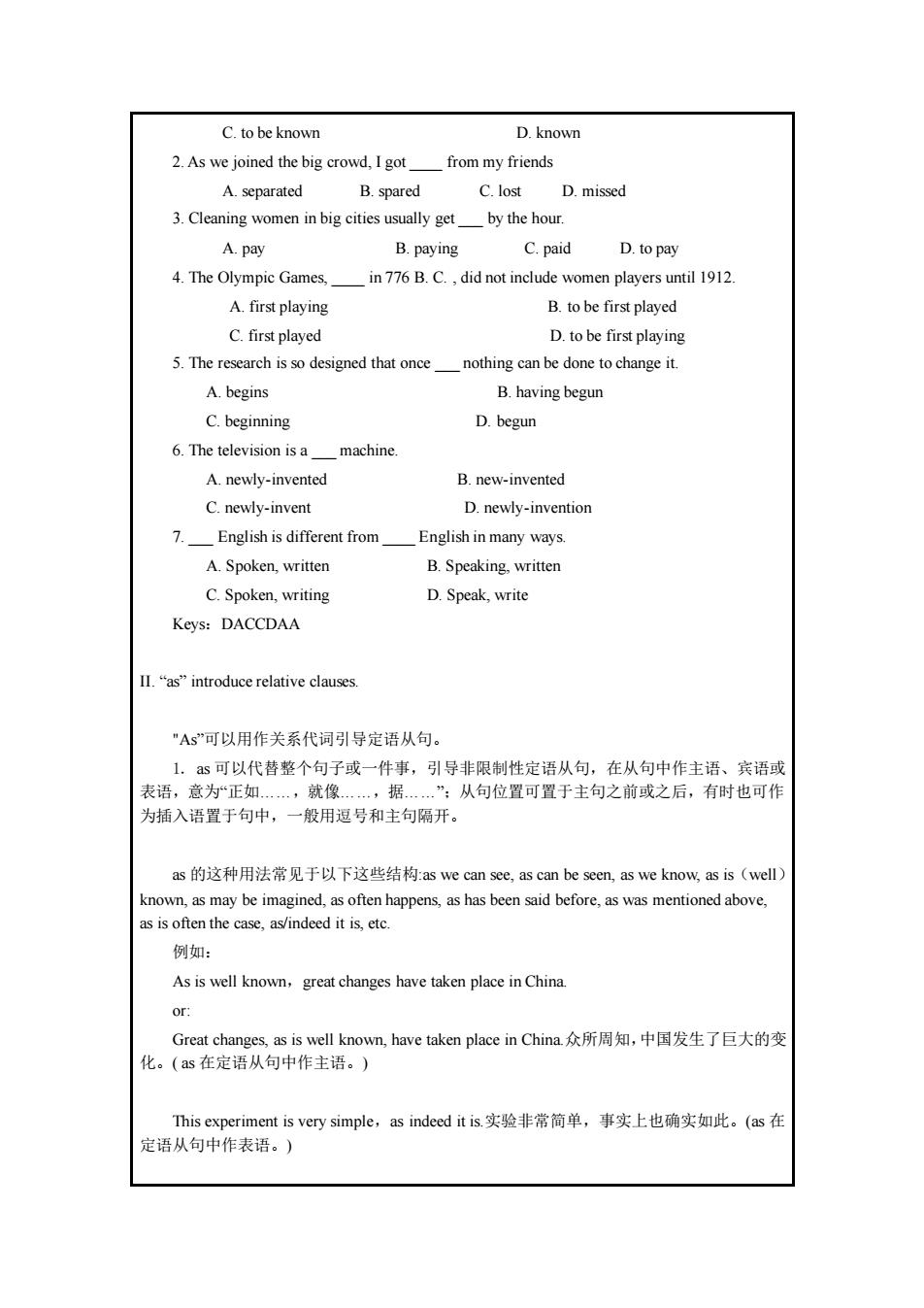
C.to be known D.known 2.As we joined the big crowd,I got from my friends A.separated B.spared C.lost D.missed 3.Cleaning women in big cities usually getby the hour. A.pay B.paying C.paid D.to pay 4.The Olympic Games, in 776 B.C.,did not include women players until 1912. A.first playing B.tobe first played C.first plaved D.to be first playing 5.The research is so designed that oncenothing can be done to change it. A.begins B.having begun C.beginning D.begun 6.The television is a machine A.newly-invented B.new-invented C.newly-invent D.newly-invention 7.English is different from English in many ways. A.Spoken.written B.Speaking.written C.Spoken,writing D.Speak,write Kevs:DACCDAA sintroduce relative clauses As”可以用作关系代词引导定语从句。 1.s可以代替整个句子或一件事,引导非限制性定语从句,在从句中作主语、宾语或 表语,意为“正加 。就像 ”:从句位置可置于主句之前或之后,有时也可作 为插入语置于句中, 般用逗号和主句隔 s的这种用法常见于以下这些结构:as we can see,.as can be seen,as we know,as is(wcll known,as may be imagined,as often happens,as has been said before,as was mentioned above, as is often the case,as/indeed it is,etc. 例如: As is well known,great changes have taken place in China 0r, Great changes,.as is well known,.have taken place in China众所周知,中国发生了巨大的 化。(s在定语从句中作主语。) This experiment is very simple,.as indeed it is.实验非常简单,事实上也确实如此。(as在 定语从句中作表语。)
C. to be known D. known 2. As we joined the big crowd, I got _ from my friends A. separated B. spared C. lost D. missed 3. Cleaning women in big cities usually get _ by the hour. A. pay B. paying C. paid D. to pay 4. The Olympic Games, _ in 776 B. C. , did not include women players until 1912. A. first playing B. to be first played C. first played D. to be first playing 5. The research is so designed that once _ nothing can be done to change it. A. begins B. having begun C. beginning D. begun 6. The television is a _ machine. A. newly-invented B. new-invented C. newly-invent D. newly-invention 7. _ English is different from _ English in many ways. A. Spoken, written B. Speaking, written C. Spoken, writing D. Speak, write Keys:DACCDAA II. “as” introduce relative clauses. "As”可以用作关系代词引导定语从句。 1. as 可以代替整个句子或一件事,引导非限制性定语从句,在从句中作主语、宾语或 表语,意为“正如.,就像.,据.”;从句位置可置于主句之前或之后,有时也可作 为插入语置于句中,一般用逗号和主句隔开。 as 的这种用法常见于以下这些结构:as we can see, as can be seen, as we know, as is(well) known, as may be imagined, as often happens, as has been said before, as was mentioned above, as is often the case, as/indeed it is, etc. 例如: As is well known,great changes have taken place in China. or: Great changes, as is well known, have taken place in China.众所周知,中国发生了巨大的变 化。( as 在定语从句中作主语。) This experiment is very simple,as indeed it is.实验非常简单,事实上也确实如此。(as 在 定语从句中作表语。)
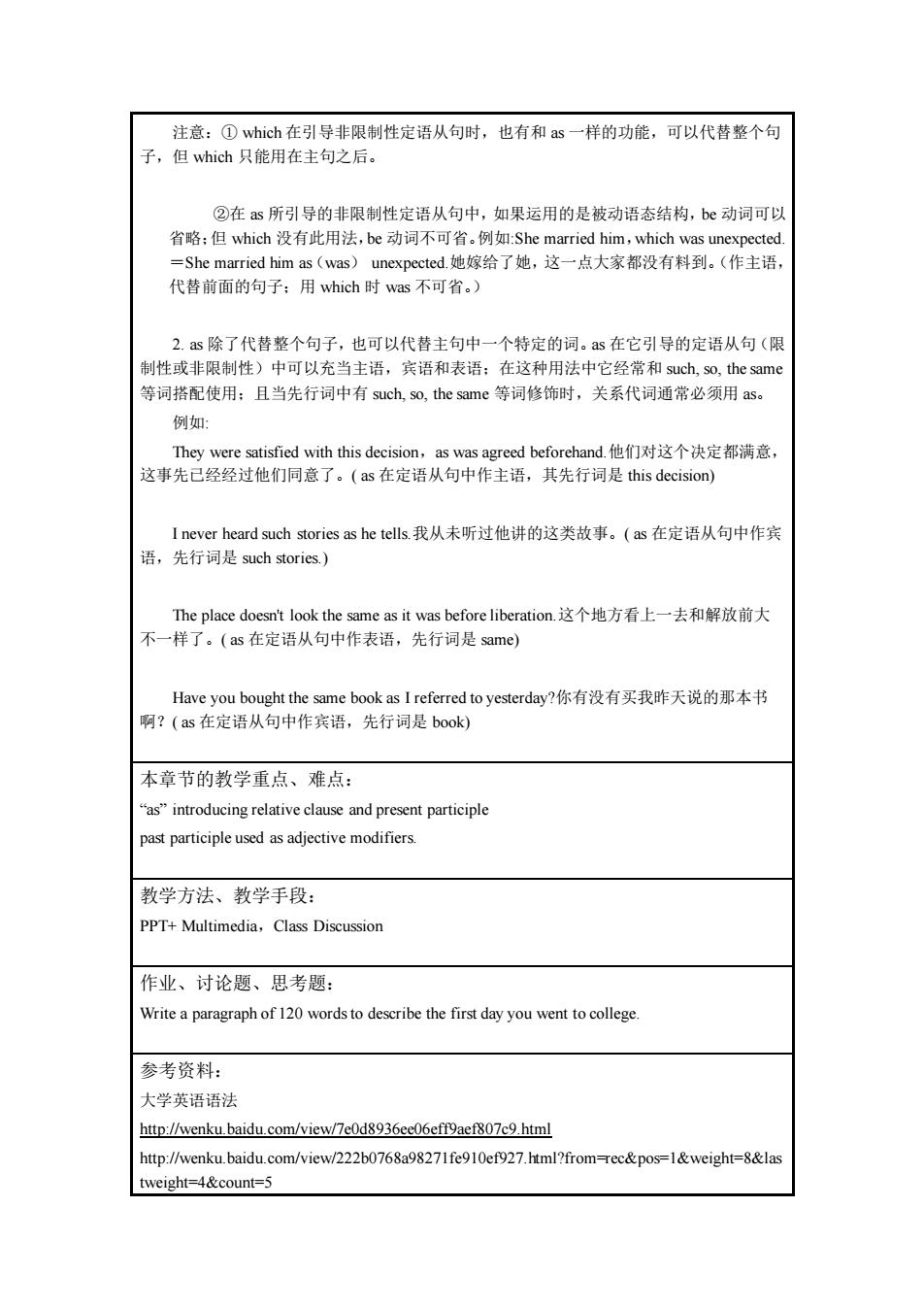
注意:①wih在引导非限制性定语从句时,也有和as一样的功能,可以代替整个句 子,但which只能用在主句之后。 ②在s所引导的非限制性定语从句中,如果运用的是被动语态结构,b动词可以 She maried him as (as) 代替前面的句子:用which时was不可省。) 2.s除了代替整个句子,也可以代替主句中一个特定的词。s在它引导的定语从句(限 制性或非限制性)中可以充当主语,宾语和表语:在这种用法中它经常和such,so,the same 等词搭配使用:且当先行词中有such,s0,the same等词修饰时,关系代词通常必须用as。 例如: They ere with this decision,as was agreed beforehand.他们对这个决定都满意 这事先已经经过他们同意了。(as在定语从句中作主语,其先行词是this decision)) I never heard such stories as he tells.我从未听过他讲的这类故事。(as在定语从句中作宾 语,先行词是such stories.) The place doesn't look the same as it was before liberation.这个地方看上一去和解放前大 不一样了。(as在定语从句中作表语,先行词是same) Have you bought the same book as I referred to yesterday??你有没有买我昨天说的那本书 啊?(s在定语从句中作宾语,先行词是book) 本章节的教学重点、难点: as"introducing relative clause and present participle past participleused asadjectivemodifiers 教学方法、教学手段: PPT+Multimedia,Class Discussion 作业、讨论题、思考题: Write a paragraph of 120 words to describe the first day you went to college. 参考资料: 大学英语语法 http://wenku.baidu.com/view/7e0d8936ee06eff9aef807c9.html http://wenku.baidu.com/view/222b0768a98271fe910ef927.html?from-ec&pos=l&weight=8&la tweight=4&coun =5
注意:① which 在引导非限制性定语从句时,也有和 as 一样的功能,可以代替整个句 子,但 which 只能用在主句之后。 ②在 as 所引导的非限制性定语从句中,如果运用的是被动语态结构,be 动词可以 省略;但 which 没有此用法,be 动词不可省。例如:She married him,which was unexpected. =She married him as(was) unexpected.她嫁给了她,这一点大家都没有料到。(作主语, 代替前面的句子;用 which 时 was 不可省。) 2. as 除了代替整个句子,也可以代替主句中一个特定的词。as 在它引导的定语从句(限 制性或非限制性)中可以充当主语,宾语和表语;在这种用法中它经常和 such, so, the same 等词搭配使用;且当先行词中有 such, so, the same 等词修饰时,关系代词通常必须用 as。 例如: They were satisfied with this decision,as was agreed beforehand.他们对这个决定都满意, 这事先已经经过他们同意了。( as 在定语从句中作主语,其先行词是 this decision) I never heard such stories as he tells.我从未听过他讲的这类故事。( as 在定语从句中作宾 语,先行词是 such stories.) The place doesn't look the same as it was before liberation.这个地方看上一去和解放前大 不一样了。( as 在定语从句中作表语,先行词是 same) Have you bought the same book as I referred to yesterday?你有没有买我昨天说的那本书 啊?( as 在定语从句中作宾语,先行词是 book) 本章节的教学重点、难点: “as” introducing relative clause and present participle past participle used as adjective modifiers. 教学方法、教学手段: PPT+ Multimedia,Class Discussion 作业、讨论题、思考题: Write a paragraph of 120 words to describe the first day you went to college. 参考资料: 大学英语语法 http://wenku.baidu.com/view/7e0d8936ee06eff9aef807c9.html http://wenku.baidu.com/view/222b0768a98271fe910ef927.html?from=rec&pos=1&weight=8&las tweight=4&count=5
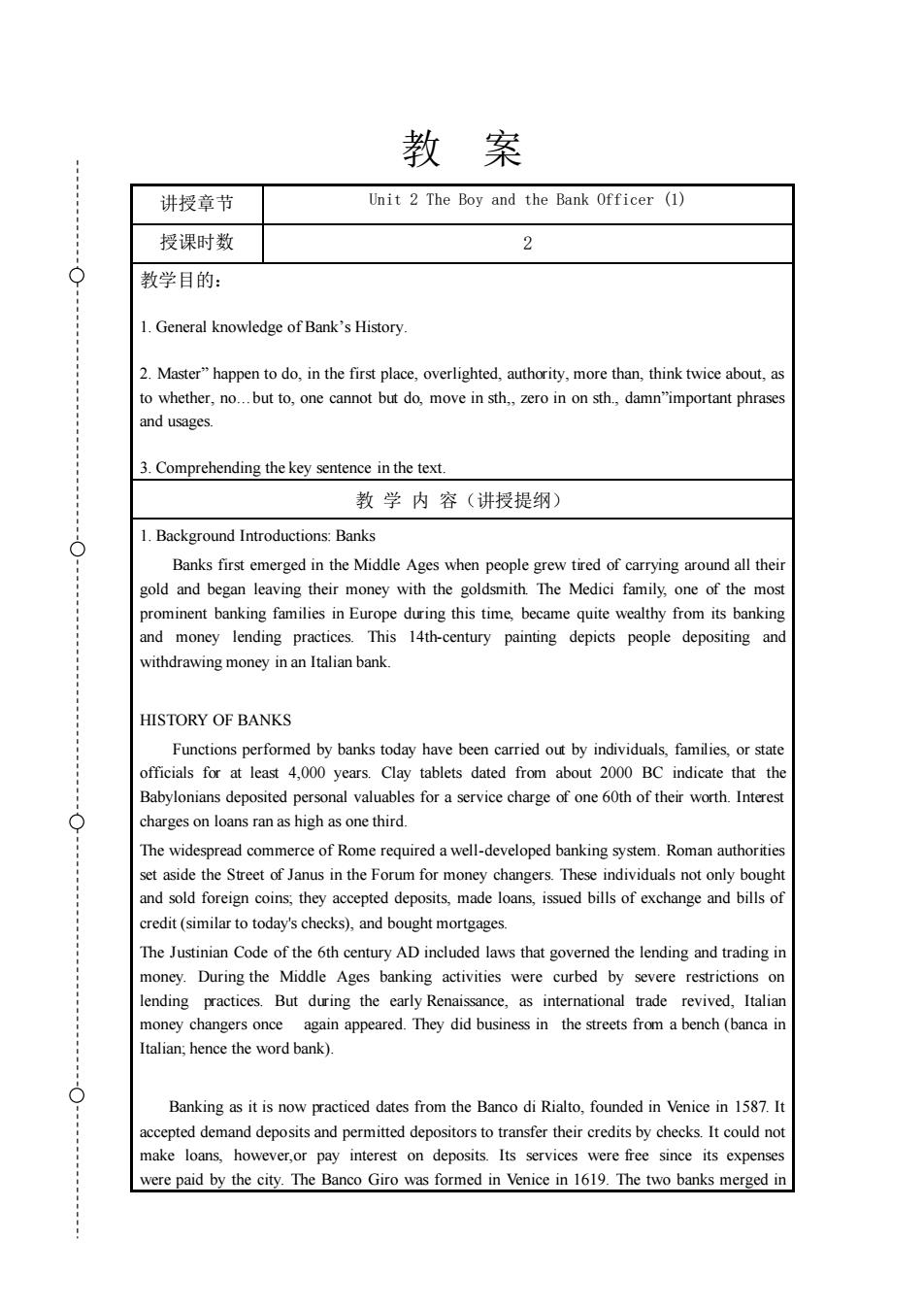
教案 讲授章节 Unit 2 The Boy and the Bank officer (1) 授课时数 2 教学目的: 1.General knowledge of Bank's History 2.Master"happen to do,in the first place,overlighted,authority,more than,think twice about,as to whether,no.but to,one cannot but do,move in sth.,zero in on sth.damn"important phrases and usages. 3.Comprehending the key sentence in the text. 教学内容(讲授提纲) 1.Background Introductions:Banks Banks first emerged in the Middle Ages when people grew tired of carrying around all their gold and began leaving their money with the goldsmith.The Medici family,one of the most prominent banking families in Europe during this time,became quite wealthy from its banking and money lending practices This painting depicts pople depositing an withdrawing money in an Italian bank HISTORY OF BANKS Babylonians deposited personal valuables for a service charge of one 60th of their worth.Interest charges on loans ran as high as one third. The widespread commerce of Rome required a well-developed banking system.Roman authoritie set aside the Street of Janus in the Forum for money changers.These individuals not only bought and sold foreign coins,they accepted deposits,made loans,issued bills of exchange and bills of credit(similar to today's checks),and bought mortgages. The Justinian Code of the 6th century AD included laws that governed the lending and trading in money.During the Middle Ages banking activities were curbed by severe restrictions on lending practices.But during the early Renaissance.as international trade revived,Italian money changersonce again appeared.They did business in the streets from a bench(banca in hence the word bank). Banking as it is now practiced dates from the Banco di Rialto,founded in Venice in 1587.I accepted demand deposits and permitted depositors to transfer their credits by checks.It could not make loans,however,or pay interest on deposits.Its services were free since its expenses were paid by the city.The Banco Giro was formed in Venice in 1619.The two banks merged in
教 案 讲授章节 Unit 2 The Boy and the Bank Officer (1) 授课时数 2 教学目的: 1. General knowledge of Bank’s History. 2. Master” happen to do, in the first place, overlighted, authority, more than, think twice about, as to whether, no.but to, one cannot but do, move in sth, zero in on sth., damn”important phrases and usages. 3. Comprehending the key sentence in the text. 教 学 内 容(讲授提纲) 1. Background Introductions: Banks Banks first emerged in the Middle Ages when people grew tired of carrying around all their gold and began leaving their money with the goldsmith. The Medici family, one of the most prominent banking families in Europe during this time, became quite wealthy from its banking and money lending practices. This 14th-century painting depicts people depositing and withdrawing money in an Italian bank. HISTORY OF BANKS Functions performed by banks today have been carried out by individuals, families, or state officials for at least 4,000 years. Clay tablets dated from about 2000 BC indicate that the Babylonians deposited personal valuables for a service charge of one 60th of their worth. Interest charges on loans ran as high as one third. The widespread commerce of Rome required a well-developed banking system. Roman authorities set aside the Street of Janus in the Forum for money changers. These individuals not only bought and sold foreign coins; they accepted deposits, made loans, issued bills of exchange and bills of credit (similar to today's checks), and bought mortgages. The Justinian Code of the 6th century AD included laws that governed the lending and trading in money. During the Middle Ages banking activities were curbed by severe restrictions on lending practices. But during the early Renaissance, as international trade revived, Italian money changers once again appeared. They did business in the streets from a bench (banca in Italian; hence the word bank). Banking as it is now practiced dates from the Banco di Rialto, founded in Venice in 1587. It accepted demand deposits and permitted depositors to transfer their credits by checks. It could not make loans, however,or pay interest on deposits. Its services were free since its expenses were paid by the city. The Banco Giro was formed in Venice in 1619. The two banks merged in